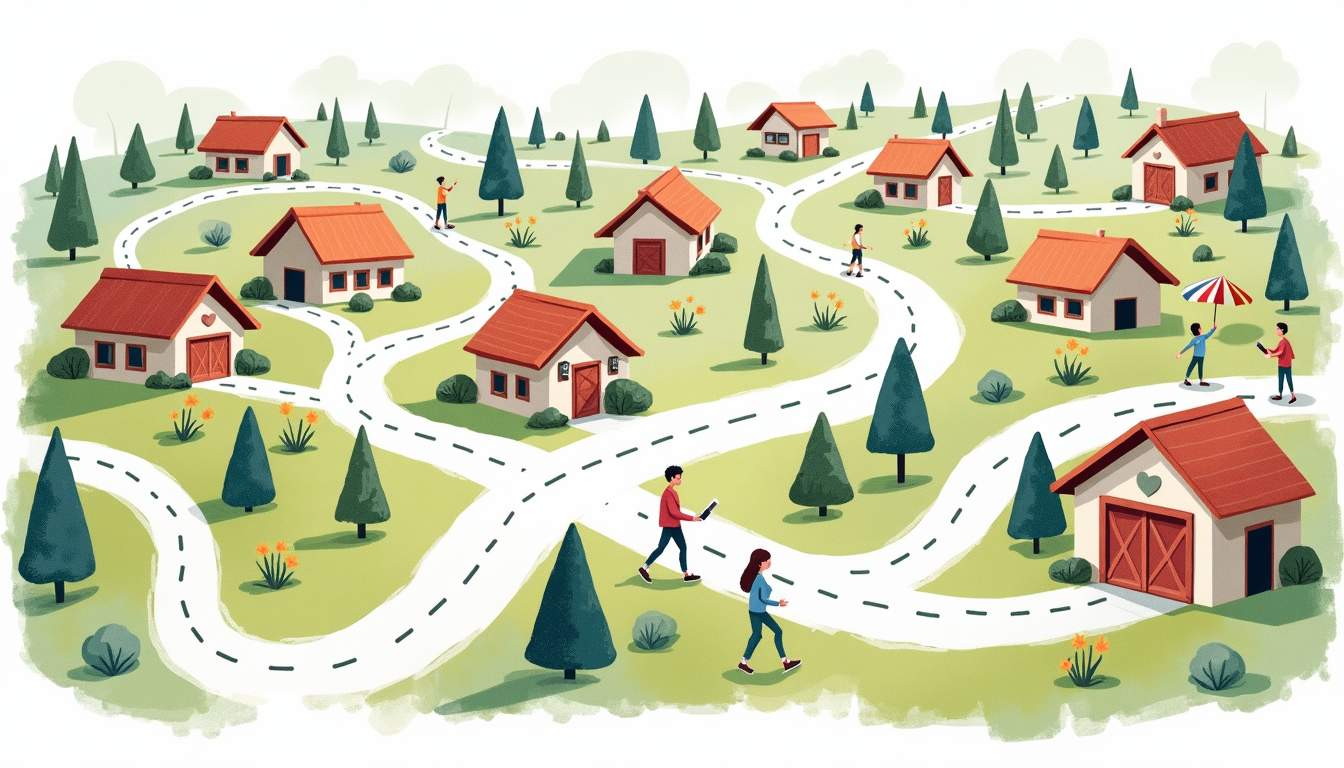
Communities are more than streets and houses; they are the living patterns of how people meet, work, care for one another, and resolve conflict. A community designed for peace intentionally arranges physical spaces, social systems, and cultural practices so that safety, dignity, and belonging are not luck but the expectation. This article explores the principles, practical steps, and measurable outcomes of designing neighborhoods, towns, and cities that prioritize peaceful coexistence.
Built environments shape behavior. A park that is well-lit and visible invites gathering rather than isolation. A market with diverse vendors fosters incidental encounters between neighbors who might otherwise never meet. The way streets are laid out, how public transport connects neighborhoods, and whether communal spaces are accessible to people of all ages and abilities either reduces friction or amplifies it.
Design is not limited to bricks and mortar. Policies, governance structures, and cultural rituals are equally part of the architecture of peace. When community rules are transparent, dispute resolution is accessible, and leadership rotates or is accountable, the social fabric becomes resilient. Those intangible structures influence trust as much as any physical design element.
Moreover, thoughtful design can help to address historical inequalities and prevent the marginalization of vulnerable groups. Incorporating inclusive principles into urban planning and community development ensures that all voices are heard and respected, fostering a shared sense of belonging. By recognizing and integrating diverse cultural identities within design practices, communities strengthen empathy and reduce misunderstandings that often fuel conflicts.
Technology also plays a growing role in designing for peace. Digital platforms that promote transparent communication, community engagement, and collaborative problem-solving can bridge divides that physical spaces alone cannot. When combined with intentional physical and social design, technology enhances the capacity of societies to not only prevent conflict but also to build lasting harmony across complex social landscapes.
Peace requires that everyone can participate. Accessibility in a broad sense means physical access for people with disabilities, affordable housing for low-income households, menus and signage in relevant languages, and cultural acknowledgement of diverse practices. Inclusion reduces the sense of otherness that often underlies conflict, turning potential flashpoints into shared assets.
Beyond these practical measures, fostering an atmosphere of psychological safety is equally vital. This involves creating opportunities for marginalized voices to be heard in community decision-making, ensuring that diverse identities are not only present but actively valued. Educational programs and community dialogues aimed at increasing intercultural understanding further strengthen these bonds, making inclusion a living, breathing practice that resists division.
Crime prevention through environmental design (CPTED) emphasizes natural surveillance, clear sightlines, and lighting to deter harmful behavior. But peace goes beyond deterrence: it creates environments where people feel comfortable taking ownership of places. Front porches, community gardens, and public seating invite a mix of users and create informal guardianship that reinforces social norms.
In addition, integrating technology thoughtfully can enhance safety without compromising community trust. For instance, well-placed, community-monitored surveillance systems paired with transparent policies help balance vigilance with respect for privacy. Landscaping that incorporates native plant species also plays a subtle role by filling spaces with natural beauty, contributing to a calming atmosphere that encourages mindful presence rather than suspicion.
Communities with mixed-use zoning — where housing, shops, schools, and services coexist — encourage casual interactions across demographic lines. Shared spaces, from playgrounds to community centers, become settings for rituals, celebrations, and everyday exchanges that nurture empathy. When people see one another regularly in benign contexts, the baseline for conflict is lowered.
Furthermore, programming these shared spaces with diverse activities—from art workshops and cultural festivals to volunteer initiatives and open forums—can deepen connections. Mixed uses also foster economic resilience by supporting local entrepreneurship and flexible spaces that adapt to changing needs. This dynamic interplay of functions helps sustain vibrant, cohesive communities where peace is actively maintained through ongoing engagement.
Trust grows when decisions are visible and voices are heard. Participatory budgeting, neighborhood councils, and public forums offer channels for citizens to influence priorities. Transparent processes reduce rumors and suspicions, while meaningful participation creates a sense of ownership that discourages destructive behavior.

Formal courts are often distant, costly, and slow. Local mediation services, community courts, and restorative justice circles provide timely, culturally appropriate ways to address harm. These mechanisms focus on repairing relationships and reintegrating people rather than merely punishing. Making such services neutral, well-publicized, and free or low-cost ensures wider use.
Peaceful communities address scarcity proactively. Job training, microfinance, and social support systems reduce the desperation that can fuel violence. Economic inclusion programs that target systemic exclusion — through language support, childcare, and credential recognition — open pathways to stable livelihoods and civic participation.
Transforming vacant lots into community gardens and neighborhood plazas shows how small investments can reshape daily life. These projects provide green space, improve air quality, and create venues for events. They often become centers for volunteerism and skill-sharing, strengthening informal networks that keep people connected and aware of one another’s needs.
In several cities, reallocating certain public safety tasks to trained civilian responders — such as mental health professionals and social workers — has reduced escalation during crises. When residents participate in defining the role and composition of local safety teams, the result is a more culturally sensitive approach that values de-escalation over confrontation.
Pedestrian-priority streets, protected bike lanes, and traffic-calmed intersections reduce accidents and make everyday life more predictable and pleasant. These changes lower stress for commuters, encourage outdoor activity, and create more opportunities for interaction. The result is a quieter, safer public realm where neighbors are more likely to greet each other than to honk past one another.
Start by identifying resources rather than deficits. Mapping assets — from cultural centers to mutual aid groups — reveals existing strengths that can be reinforced. Asset-based approaches empower residents to build on what already works and to connect dots between services that might otherwise remain isolated.
Testing changes at small scale allows for experimentation without risking widespread disruption. Temporary installations — such as popup markets, parklets, or weekend street closures — offer quick feedback and visual proof of concept. Iteration based on community feedback ensures solutions are grounded and adaptable.
Local governments, nonprofits, businesses, faith groups, and educational institutions each bring different capacities. When aligned around shared goals, these partners can pool funding, technical expertise, and social reach. Collaboration also helps ensure that interventions are culturally appropriate and sustainably financed.
Quantifying peace is challenging but necessary for accountability. Traditional crime statistics are important but incomplete. Complementary measures include surveys of perceived safety, rates of mediation use, levels of civic participation, access to services, and indicators of social cohesion like volunteer hours and attendance at community events.

Longitudinal measures help identify trends and the impact of specific interventions. Ultimately, metrics should be selected in collaboration with residents so that evaluation reflects community values rather than external priorities alone.
Improvements in public spaces can unintentionally increase property values and displace longtime residents. Anti-displacement strategies — such as community land trusts, tenant protections, and inclusionary zoning — are essential companions to beautification and amenity projects. Prioritizing affordability maintains the social mix that undergirds peace.

Different groups will inevitably disagree about what the community needs. Structured dialogue processes, clear decision rules, and equitable representation can prevent conflict from escalating. Listening sessions that reach beyond the most vocal participants to include marginalized voices help ensure decisions are legitimate.
Budget limits require creativity. Volunteer engagement, phased projects, and leveraging small grants can move initiatives forward. Demonstrating early wins builds momentum and helps unlock larger funding sources. Framing projects to show multiple benefits — health, economic, climate resilience — attracts broader support.
Routine social customs can be designed to knit people together: neighborhood potlucks, time banks, shared childcare co-ops, and skill exchanges foster mutual aid. School programs that bring families together across differences, interfaith dialogues, and arts initiatives that celebrate diverse stories build empathy and reduce stereotyping.
Consistent, low-cost practices compound over time. A monthly community cleanup or a regular public reading series becomes part of the neighborhood rhythm, creating predictable moments where relationships are strengthened and civic norms are visible.
Peaceful communities are adaptive. They prepare for shocks — economic downturns, natural disasters, demographic shifts — by embedding flexibility into systems. Shared emergency plans, diversified local economies, and distributed food and energy resources reduce vulnerability and keep social networks intact when crises occur.
Investment in youth and intergenerational programming ensures that norms of peaceful coexistence are transmitted. When young people have meaningful roles and safe spaces, the likelihood of violence decreases and leadership pipelines grow stronger.
Designing a community for peace is an ongoing practice rather than a one-time project. It requires aligning physical space with social systems, ensuring inclusion, and creating mechanisms for accountability and healing. The most successful efforts are those that start with listening, prioritize equitable outcomes, and iterate based on lived experience.
Peace does not mean the absence of disagreement; it means equipping people with the tools, spaces, and relationships that allow differences to be aired, negotiated, and reconciled without harm. Communities designed for peace are investments in quality of life, public health, and democratic vitality — and they demonstrate that intentional design can transform how people live together.
Embrace a lifestyle where thoughtful design and community come together in perfect harmony. At Tennessee National, experience the tranquility of a premier gated community set against Tennessee’s stunning landscapes, featuring exceptional amenities that foster connection, inclusion, and well-being. From scenic nature trails to engaging social clubs and a Greg Norman Signature Golf Course, every detail supports peace and belonging. Schedule a private tour today and begin your journey toward a life designed for lasting harmony and joy.